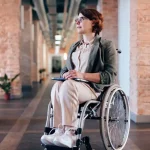When You Must Use Stairs with a Cane
Recently, I traveled to a county government building with a lady forced to use stairs with a cane. It was an adventure.
I was surprised that access to this building took a lot of work for a cane user. The building would have been entirely inaccessible to a walker or wheelchair user.
The Americans with Disabilities Act applies to government buildings and many other public buildings. People with different kinds of mobility disabilities can get into and use other government buildings I’ve been to.
In other facilities, signs pointed people to ramps, elevators, parking spots, and entrances and exits that were easy for people with disabilities to use.
Obstacles to Accessibility
According to the county building’s website, this building had several elevator entrances from the parking garage below. Unfortunately, we have yet to find any of them.
The only elevators we found led to a sizeable ground-level plaza where traveling the path to the front doors of the building took between five and ten minutes. However, I saw no signs and no ramps or elevators for the disabled or elderly in this building.
Once inside the doors, I expected a ground-floor lobby with main elevators. No, there was a flight of stairs to the main elevators, that’s all.
No elevator and no ramp for the mobility-disabled were provided. So, my companion had to climb the stairs, about ten of them, to the main elevators.
Luckily, she knew how to use her cane correctly, held on to the handrails, and took them step-by-step up to the top. A wheelchair or walker user would have been halted at the front doors by the stairs.
After our business had been conducted, we sought another way out of the building, hoping to find an elevator that would take us to the parking garage or help us avoid the staircase.
That side of the building was under construction, I was told. So, going down the stairs was the only way out of the building.
It took her some effort and time, but she did get down the stairs safely, where she again faced a walk across the plaza to get to the parking garage.
Using a Cane on Stairs
Do you know how to safely use stairs with a cane?
You may need to know how to do this someday.
First, place your cane in your hand opposite your weaker or stiff leg to climb stairs.
With your free hand, grasp the handrail.
Step up on your good leg first, then on the weaker leg.
To climb down the stairs,
put your cane on the step first, then your weaker leg, and finally, your suitable leg to support your body weight.
If you are a companion to a cane user, walk at the side of the person on the steps. Take time and ensure they place each foot squarely on the step.
They may need to rest for a moment between steps. Don’t attempt stair-climbing on dimly lit steps or narrow, steep steps that would be challenging even to the able-bodied.
Accessible to All
If I had to take my friend to this building again, I would call ahead. Find exactly where handicapped-accessible elevators are from the parking garage, so we can avoid the stairs.
Better still, I would ask if I could transact business by mail, fax, or email with the office, instead of traveling there. And I will find someone in that government office to complain about the obstacles she faced today.
Disabled and elderly people are part of the public. Public buildings should be accessible for all citizens, including those who use canes, walkers, or wheelchairs to get around.
To Conclude
For all citizens, including those who rely on canes, walkers, or wheelchairs, government buildings and other public spaces must be designed with accessibility in mind.
The article discussed the best ways to safely tackle stairs when using a cane and the necessity of having access for people with disabilities.
Individuals must be aware of a building’s level of accessibility before visiting and actively work to ensure public places are accessible for all.

